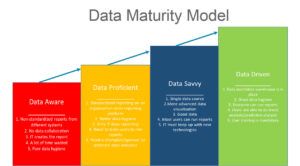
Data needs to have the following six characteristics to be considered good: it must be complete, accurate, available, reliable, consistent, and up-to-date.
As Ted Friedman of Gartner states, “Data is useful. High-quality, well-understood, auditable data is priceless.”
Think about it. Even if just one factor is lacking, the data quality and the use of this data suffer greatly. For example, imagine that an association’s data is complete in every way, but it cannot readily be made available to users and decision makers. The value of that data is diminished tremendously. Similarly, let’s suppose that an organization has five components of good data operating efficiently, but the information is always a month behind.
What insights could the executive leadership and management teams be missing?
How much less agile and responsive will an organization be based on this lag time?
Organizations with a sophisticated data and analytics approach report better business performance, greater staff and constituent satisfaction, higher operating margins, reduced costs, increased sales, and other benefits.
“The goal,” says Carly Fiorina, former executive, president, and chair of HP, “is to turn data into information, and information into insight.”
As these advanced organizations are able to nurture a “single version of the truth” about their businesses, employees develop a greater confidence in their analytical systems. Additionally, leaders are in a position to utilize real-time data to anticipate changes with business lines or in the industry to make well-informed decisions and/or take corrective action.
The process of turning data into information is never ending. Yet, it is possible to manage an organization’s progress toward increased sophistication, by plotting that progress against an objective maturity model. The IntelliData’s Data Maturity Model delineates four stages of association data maturity.

The first stage is Data Aware. Characteristics of organizations that are Data Aware include the use of multiple data sources and databases. However, these systems are siloed and lack integrations. Employees know where data is stored but are unable to readily access this information. They may be able to run basic reports but are heavily IT-dependent. These organizations exhibit poor data hygiene with duplicate records and bad data. To move to the next stage, organizations will need to implement processes and user training.
An organization that finds itself in the Data Proficient stage may be using multiple data sources and databases with little or no integration. They know where data is stored and how to retrieve it, but data quality is sometimes questionable. Staff members are able to run reports and manipulate data. They are ready to track KPI’s (key performance indicators) but may need executive sponsorship to advance further. They organization needs to learn how to use data efficiently to be able to move to the Data Savvy stage.
Data Savvy organizations have few or no silos of data. Different data sources are integrated, and executive sponsors are in a position to break down any remaining organizational or data silos. IT keeps up with new technologies, stores data effectively, and is able to provide data on demand to various departments and teams. Data is used to make critical business decisions. What is remaining to achieve for an organization at this stage is a focus on building advanced capabilities such as data warehouses and predictive analytics.
The Data Driven stage is the level all associations should strive for. Data is embedded into all business processes and decisions. IT has integrated all data sources and has implemented an advanced analytics platform. IT and the business as a whole are functioning as a tight, cohesive unit. Furthermore, the objectives of the organization are to scale the data strategy while continuing to reduce costs.
How does your organization’s use of data compare? What will it take to gain greater buy-in and ensure collaboration to progress to the next stage of data maturity?